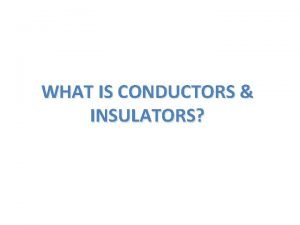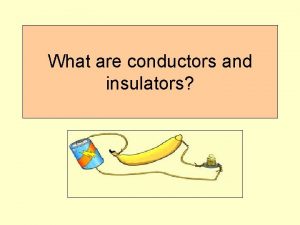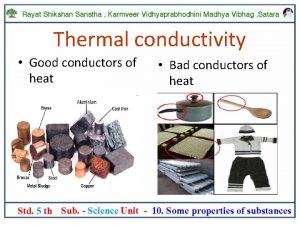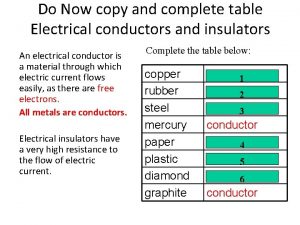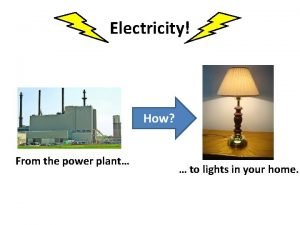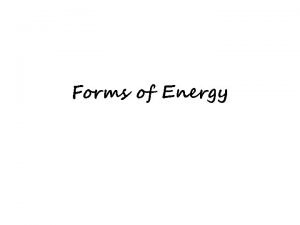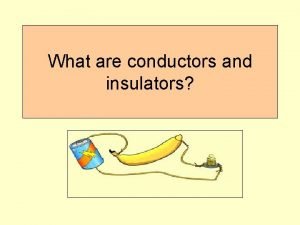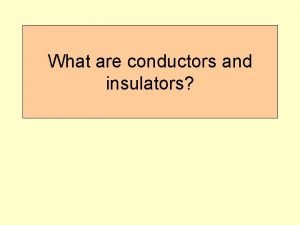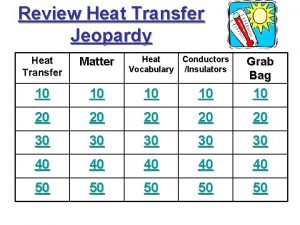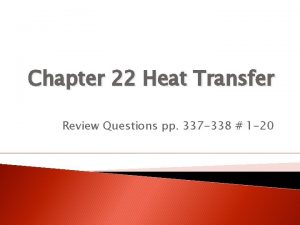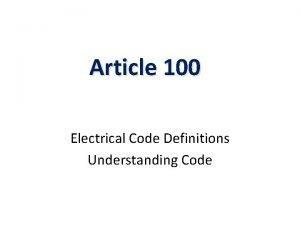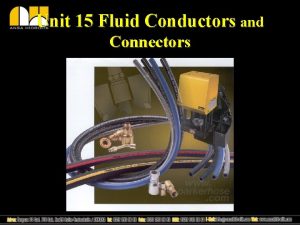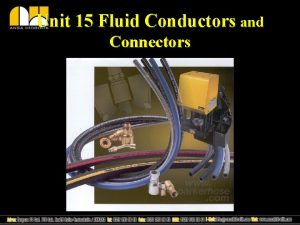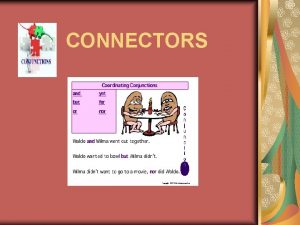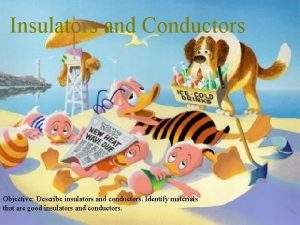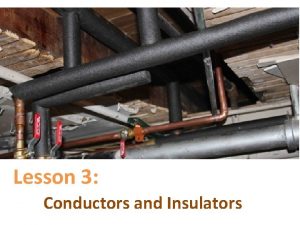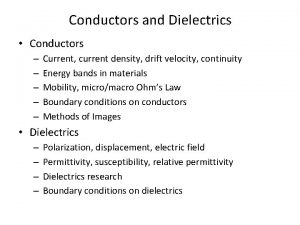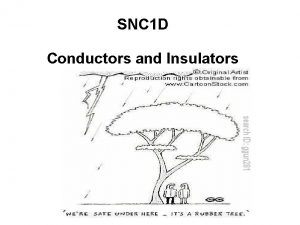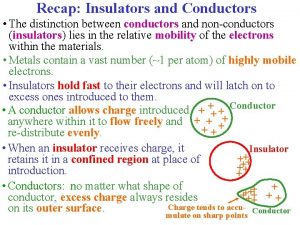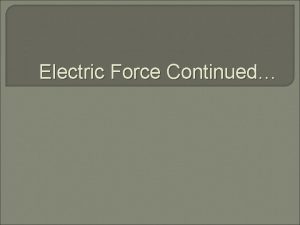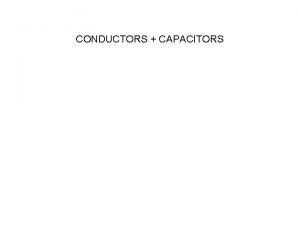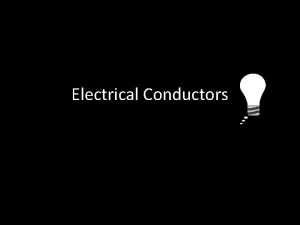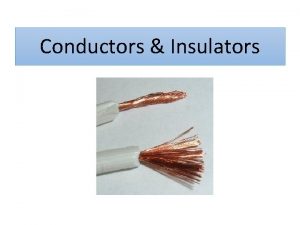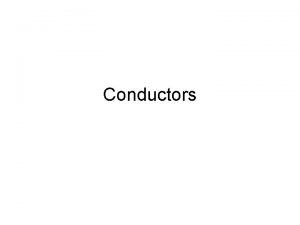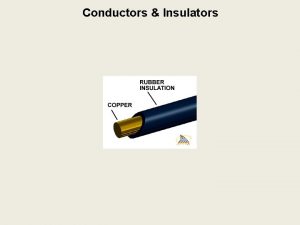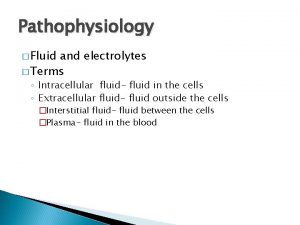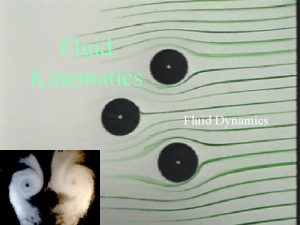Unit 15 Fluid Conductors and Connectors Connectors Up



























- Slides: 27

Unit 15 Fluid Conductors and Connectors

Connectors Up to this point we have discussed components of fluid power systems without attention to their connections. Conductors carry fluid from the power source to the system components and eventually the point of operation. To function properly, as well as safely, conductors must be able to withstand the highest possible pressure of the system, deliver the fluid at required volumes, withstand high operating temperatures, and remain leak free during operation. Conductors are classified as either rigid, semi-rigid, or flexible. Conductors are referred to b type such as pipe, tubing, and hose. Pipe is considered rigid. Tubing is considered semi-rigid, and hose is considered to be flexible. The first conductor we will discuss is pipe.

Pipe and Materials and Sealing Pipe is a rigid conductor which means it is not meant to be bent. Consequently, pipe must be connected using fittings and, as a rule, everywhere there is a connection in a fluid power system there exists the possibility of a leak. Materials There are many materials that could be used for pipe but only seamless steel is recommended for hydraulic systems. Galvanized pipe is not recommended because of chips. Sealing Pipe threads have to be tapered and usually use NPTF type thread.

ID, OD, and Wall Thickness and Pipe Size Wall thickness determines the pressure rating of the pipe. Schedule 40, 80, and 160 are most common and are designated as low pressure, high pressure, and very high pressure respectively.

Pipe Threads To form a leak proof seal, pipe threads are tapered on their outside diameter about 1/16 th per inch. This taper causes an interference fit which is suppose to create a seal. In reality pipe threads don’t seal very well without the help of pipe tape or joint compounds.

Pipe Threads NPTF type pipe thread is recommended for hydraulic systems. The major difference NPT and NPTF type thread is in the clearance left between the crest and root of the thread. With the NPTF type, there is no clearance which aids in sealing.

Pipe Fittings Since pipe is heavy walled and not designed for bending into shape, fittings must be used to make pipe connections. Fittings are also used on tubing to connect sections.

Pipe Installation Considerations Since metal is removed when threading, it is critical that metal shavings not be allowed to get in the system. When applying sealing compounds, make sure not to allow any of the compound to overlap the end of the pipe. Never start sealant tape any closer to the edge than two threads. When tightening pipe threads, be aware that the wedging action generates radial force on the outer pipe and that over tightening pipe threads can result in a rupture.

Tubing The main advantage of tubing is that it can be bent into shape and thus requires fewer fittings. Fewer connections generally means there will be less possibility of leaks. Tubing is also known for its ability to absorb vibration and has a smooth inside finish which is good for fluid movement.

Tubing Materials Steel Copper Brass Aluminum Stainless Steel Plastic Although tubing may be made of many different materials, fluid power systems only use one or more of them. Generally, carbon steel tubing is the choice of hydraulic systems and either steel or plastic tubing for pneumatic systems. Aluminum, copper, and brass have the tendency to fracture. Stainless steel is expensive.

Tubing Size Tubing size is determined by outside diameter. As tubing wall thickness increases, its internal diameter decreases. As wall thickness increases, the burst pressure of the tubing also increases.

Tubing Size and Pressure Rating Three very important terms associated with tubing are: burst pressure, working pressure, and safety factor. Burst pressure is the point at which a tube will rupture at a given pressure value. Working pressure is the value considered safe to operate the system at under normal circumstances. Safety factor is the ratio between working pressure and burst pressure. As a general rule, a good safety factor is at least 4 to 1.

Tube Fittings Tube fittings generally fall into one of two categories: flared and flare-less. A flared tube fitting, shown above at left, consists of a body, sleeve, and a nut. A seal is generated between the tube flare and the body when the nut is tightened against the sleeve and tube. The main reason of the sleeve is to keep the nut from twisting the tube flared end when the nut is tightened. It is important to note that some flare assemblies, such as low pressure 45 degree flares, do not use a sleeve. Flare-less tube fittings use basically the same components except that the seal is created by a donut shaped piece that is sometimes referred to as a “ferrule” rather than a sleeve.

Flared Tube Fitting 37 degree Flare Fitting SAE “B” Ferrule Compression Fitting JIC 37 degree flares are recommended for high pressures above 1000 PSI. SAE 45 degree flares are primarily used in pneumatic systems and are for pressures below 1000 PSI. The flare-less tube fitting can be used in both hydraulic and pneumatic systems and has pressure ranges up to 3000 PSI. Flare-less tube fittings should be used on medium and heavy wall tubing. The most critical step in making a single flare tube fitting is forming the flare. The tube must be cut square, cleaned free of burrs, measured exactly, and flared without galling, over-thinning, or splitting the end of the tube.

Flare Less Tube Fitting Sleeve Type Compression Fitting O-Ring Type Compression Fitting The types above are used when tubing cannot be flared or to avoid flaring. In both cases the sleeve holds the tube in place.

Tubing Installation As a rule, tubing runs should be kept as short as possible with as few bends or turns as possible but not completely straight. Bends do help absorb vibration and allow for expansion and contraction.

Tube Bending Radius Hydraulic tubing is bent with a special tool. Each tube has a standard bend radius to which the tube may be bent without flattening, kinking, or wrinkling. The rule of thumb for calculating the bend radius is given by the following formula: Bend Radius + 3 X Outside Diameter of Tube. The bend radius is measured from the inside center of the radius to the centerline of the tube, not the outside as done with a hose.

Hose Reinforcement Inner Tube Outer Cover The standard components of a three piece hose assembly are the inner tube, reinforcement layer, and the outer cover. The inner tube comes into direct contact with the fluid and must be compatible with it. The reinforcement layers provide strength for the hose and must be able to withstand the system pressure. The outer cover protects the other two by providing a contact surface for the hose. The outer cover should not be allowed to rub against anything during normal operation.

Hose Construction Although basic hose construction includes three pieces, hoses can be constructed with multiple reinforcement layers made from many materials including steel that give the hose three possible ratings: suction, medium pressure, high pressure, and very high pressure.

Hose Size Hose size is given by a “dash” number which relates to the inside diameter of the hose. The dash numbers graduate in 1/16 th increments. A hose with a – 16 imprinted on the side would have an inside diameter of 1 inch. A hose could have a very large outside diameter but a very small inside diameter so trying to judge inside diameter by examining the outside diameter is not practical.

Hose Pressure Classifications The pressure rating of a hose is determined by its construction. The more reinforcement layers a hose has, the more pressure it can stand. In addition to layers, the type of reinforcement also pays a role in determining the pressure rating of a hose.

Hose Fittings Hose fittings can be classified as either permanent or reusable. Permanent hose fittings are installed on the hose by “crimping” and cannot be disassembled. Reusable hose fittings are screwed or clamped on the hose end. The big difference between skive and no-skive hose is in the thickness of the outer cover. The thicker cover requires a different fitting shell.

Quick Couplings Quick couplings are used for convenience because they can installed and removed by hand in situations where there will be repeated connecting and disconnecting of lines. There are three kinds of couplings: single shutoff, double shutoff, and straight through. Single shutoffs are used with compressed air. Double shutoffs are used with liquids, and straight through are used where flow must be unrestricted.

Hose Installation Considerations Avoid twisting hose. Small twists in a hydraulic hose can have devastating results. Do not install hose tight as in the illustration on the right. Hose needs room to expand contract.

Hose Installation Considerations Hose movement needs to be considered on equipment using pivoting actuators. The cover should not be allowed to come into contact with any other machine part as the machine operates.

Hose Installation Considerations Hydraulic hose will expand with pressure and at the same time shorten in length. Secure all hoses firmly being careful to allow for some movement.

Hose Bend Radius Two conditions that contribute to shortened service life are installing the hose twisted or over bent. A small twist in a hose, as little as 10 degrees, can shorten the life of the hose by 90 percent. Examine the “lay line” during installation to ensure there are no twists in the hose. The minimum recommended bend radius of a hose is determined by manufacturers who specify limits on charts.
 Intracellular fluid and extracellular fluid examples
Intracellular fluid and extracellular fluid examples Movement of body fluids
Movement of body fluids Fluid sf
Fluid sf P1-p2
P1-p2 Fluid statics deals with
Fluid statics deals with Interstitial fluid vs extracellular fluid
Interstitial fluid vs extracellular fluid Interstitial fluid vs extracellular fluid
Interstitial fluid vs extracellular fluid Define fluid kinematics
Define fluid kinematics Morison's pouch
Morison's pouch What is an electrical conductor
What is an electrical conductor What are conductors and insulators
What are conductors and insulators Good conductors
Good conductors Calculate voltage across resistor
Calculate voltage across resistor Trade theory in electrical installation
Trade theory in electrical installation Type nms cable contains
Type nms cable contains Table of conductors and insulators
Table of conductors and insulators Bad conductor of electricity
Bad conductor of electricity Study jams conductors and insulators
Study jams conductors and insulators Physics 2135
Physics 2135 Penny insulator or conductor
Penny insulator or conductor Unit 10, unit 10 review tests, unit 10 general test
Unit 10, unit 10 review tests, unit 10 general test What are conductors
What are conductors Is scissors a conductor or insulator
Is scissors a conductor or insulator Jeopardy
Jeopardy Conductor atomic structure
Conductor atomic structure Heat conductors
Heat conductors Dominoes are placed upright in a row
Dominoes are placed upright in a row A feeder consists of all circuit conductors located
A feeder consists of all circuit conductors located









